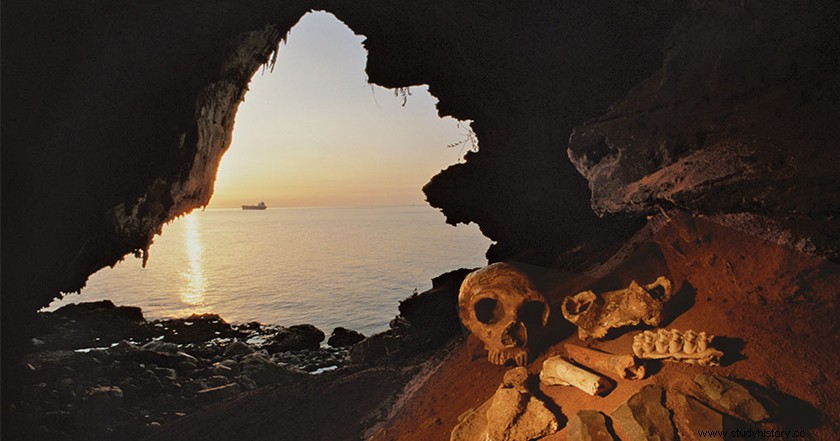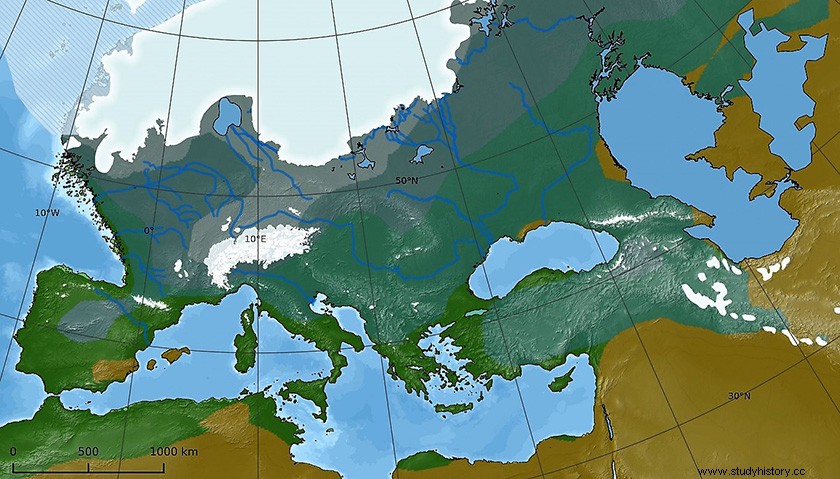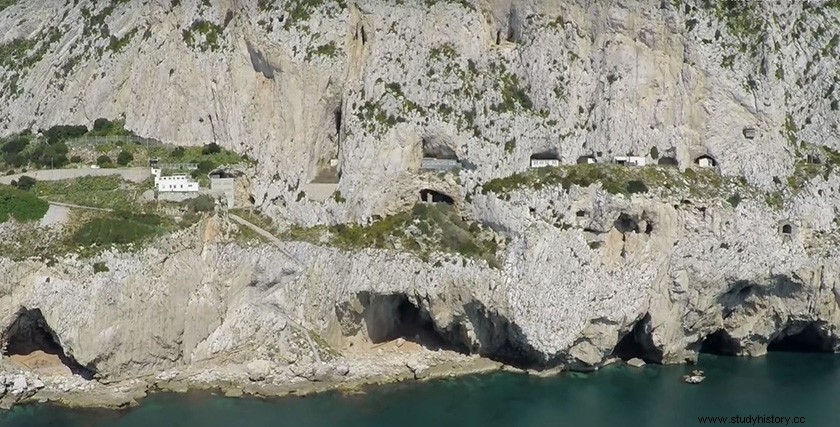
How could it be, that those hominids who dominated Middle Paleolithic Europe, were they not able to continue living after the arrival of Homo Sapiens?
This was the big question that fluttered any congress, or meeting between prehistorians and anthropologists for many years, today it has practically gone into the background, to give way to continuous news that extol the figure of the Neanderthals. And it is that there are many hypotheses that have been raised since the coexistence of the two species in Europe was known; at least they did between 12,000 and 16,000 years, which goes from the arrival of the HAM (anatomically modern man), to the extinction of the last Neanderthal.

Maximum expansion of the Neanderthals.
These hypotheses have ranged from a great war between species raised at the beginning of the 20th century, to the eruption of several volcanoes 40,000 years ago, which decimated the Neanderthal population, leading it to its disappearance. Both theories are widely rejected, since there are no archaeological indications of lasting encounters in time, nor an explanation of why these eruptions did not affect the first Homo Sapiens. Another hypothesis:inbreeding with Homo Sapiens is not ruled out, but insufficient to explain the end of a species, since it is very difficult to think that the result of their sexual encounter would bear fruit, and even more so that they would progress, all of this despite the different interpretations that have been given to the finding of the Lapedo boy.
Going back to the question at the beginning, today it will be assumed that the mixture of various hypotheses from those raised in those work tables is the best solution to explain the end of the last neanderthal The assumptions that have had the most supporters are the geographical pressure exerted by Homo Sapiens, the lack of adaptation to the harsh climatic conditions that occurred in the Upper Palaeolithic, or the continuous outbreeding of the Neanderthals. Well, in these three hypotheses, the small Gorham's cave , located in Gibraltar, has said and has much to say.

Gorham's Cave
A journey through Neanderthal Europe.
When Homo Sapiens first set foot on the European continent, between 45,000-40,000 years ago, Neanderthals had begun their decline as a species. The new hominids arrived with a technology, called Aurignacian, much superior to the traditional Mousterian of the Neanderthals, which surely provided better adaptation to the worsening climate. In such a way that the Neanderthals were forced to start a long migration to the south of the continent. If there was any type of direct encounter between both species at this first moment, it must have been circumstantial, since we must think that 40,000 years ago the cold dominated the continent, in addition the great forests were scarce, giving way to a tundra landscape with enormous icy steppes much of the year and huge distances to travel without encountering a human being.

Europe under the great ice age
The next 12,000 years will be a race against time for the Neanderthals to survive. An aside to remember that when we talk about prehistory, the years jump very quickly, without realizing that the life expectancy of a Neanderthal could be around 30 years, and therefore we are talking about hundreds of generations in search of supposedly better weather conditions to survive.
Around 35,000 years ago, that is, after five millennia of alleged cohabitation, the Neanderthals who were the great rulers of Europe and the Middle East, were reduced to three geographical areas. Also, always around the maritime fringes; in the Atlantic from Cantabria to Brittany, in the Mediterranean the two peninsulas, Italic and Iberian, and finally the Balkan area from the Adriatic to the Black Sea. While Homo Sapiens had taken over the entire European center, in search of the great herds of mammals.
Over the next 5,000 years, Neanderthals progressively disappeared from different areas. In the first place, from the Italian Peninsula, later the union of groups between the Adriatic and Black seas was definitively broken, and the geographical spaces in the Atlantic diminished rapidly. In such a way that we arrive at 30,000 years ago; where the south of the Iberian Peninsula becomes their only refuge and 2000 years later the only Neanderthals in Europe are found in a narrow strip of territory of very few kilometers.
Gorham's Cave.
We are heading to Gibraltar, that is, at the southernmost point of the Iberian Peninsula, next to Punta de Tarifa. There are a series of caves with difficult land access, which is why they were located in 1907 by the English sailor of the same name. After successive excavations in Gorham's cave, four main periods of occupation have been located. The most recent during the colonial period of the Phoenicians, followed by the full Neolithic, and after the Magdalenian and Solutrean period. Finally, highlighting as the most important the finding of numerous Mousterian objects, scrapers, arrowheads or knives, its dating between 28,000-24,000 years makes it the most recent occupation of the Neanderthal. Although no bone remains have been found to confirm this, the Mousterian technique can only be assigned to Neanderthals.

Gibraltar limestone rock with lots of caves.
Although it is to enter fully into the field of speculation, thanks to the interpretation of the archaeological remains found, both in Gorham, and in the rest of the Iberian Peninsula, we can closer to the life of these supposed last Neanderthals of Gibraltar. In the first place, we can think that they must have had very few contacts with Homo Sapiens, this fact is deducible precisely because they continue to use this Mousterian technology. Today, contacts between Sapiens and Neanderthals are accepted in places such as the Cantabrian Coast, Catalonia, and the south of France. This aspect is reflected by the adoption of a new technology, evolved from the Mousterian after contact between species, and called Châtelperronian.
The Neanderthals that inhabited Gorham's Cave they had to gradually adapt to a new diet. His hunting ground was right in front of his caves, if today we find nothing but water, 25,000 years ago with the glacial period, there were at least five kilometers of steppes. Some experts have called this area the “Mediterranean Serengeti ”. The large mammals that this species had hunted throughout the Middle Palaeolithic did not exist here, but rather deer, goats, rabbits and, of course, crustaceans such as limpets and mussels on the coast. In addition to great plant resources, such as pine nuts, fruit trees or roots, which the Neanderthals incorporated into their diet. This aspect cannot be seen as a cause of its extinction, but on the contrary a form of adaptation that led it to survive as a species.
The disappearance of the last Neanderthal.
As has been pointed out previously, the main hypotheses about the disappearance of the Neanderthals come to mind, when verifying some aspects of Gorham's Cave.

Reconstruction of Neanderthal appearance
The first two seem very obvious; the arrival of Homo Sapiens could have finished, or cornered the Neanderthal bands to the south, since thanks to better technology they could exercise better control over resources. On the other hand, the flight to the south, or simply a better acclimatization of the Neanderthals from the southernmost positions of the Iberian Peninsula, can reveal a lack of adaptation to the harsh climate of the last great ice age. There are also questions about this aspect, since it is usually dated between the last 70,000-10,000 years. That is, Neanderthals survived the ice age long before the arrival of Homo Sapiens. Although, on the other hand, we must point out that the maximum period of cold occurred 22,000 years ago, shortly after the disappearance of our protagonist, who could well have succumbed at the beginning of this new upsurge.
But it seems clear that in Gorham's caves, neither the lack of resources, nor the adaptation to cold, could end the life of the last Neanderthals. Therefore, the third of the hypotheses, inbreeding, that is, the procreation between individuals of the same family that impoverishes the species, only made the first two hypotheses worse. Therefore, what happened inside that Gorham's Cave is the result of thousands of years of evolution of the Neanderthal species.
At this point it is necessary to highlight that the Iberian Peninsula has become in recent years the great European laboratory for the knowledge of Neanderthal society. If at the beginning of the 20th century, a Neanderthal was seen as just another hunting species, the different archaeological findings that have supported the program for the study of the Neanderthal genome, only that they have given continued surprises. The Neanderthals were closer to our species than had been supposed at first, they buried their dead, they painted their caves, and they had a great sense of the individual as an element of society. Even so, and according to these studies the species was already mortally wounded before the arrival of Homo Sapiens, some calculations say that 50,000 years ago there were about 7,000 men and 3,500 women, clearly unable to find spaces for coexistence.

Shell that served as a pendant to a Neanderthal
Their social reality, according to findings in the caves of L'Abric Romaní in Barcelona or El Sidrón in Asturias, was the family unit of about 12 members in a state close to sedentarization. In addition, its scope of action should not have been very extensive, greatly reducing contacts with other families. In the first of the deposits, clear indications of rooms with distribution of tasks have been found under the rocky shelters. Without a doubt, this is one of the main differences with Homo Sapiens, who traveled long distances in search of herds, and there are even clear signs of collaboration between tribes.
After this journey through prehistory, it may be easier for us to imagine the last days of a Neanderthal, either in Gorham's Cave, or with great probability in another nearby place to this, and that today remains under the sea. In complete solitude, whether male or female, and with no option to procreate, the last Neanderthal died, leaving the world under the rule of a single human species.
More info:
Brief history of the Neanderthals, Fernando Díez Martín, Ed. Nowtilus, 2011
Ancient Prehistory of the Iberian Peninsula, Coord. Mario Menéndez, Ed. Uned, 2012
www.gibmuseum
